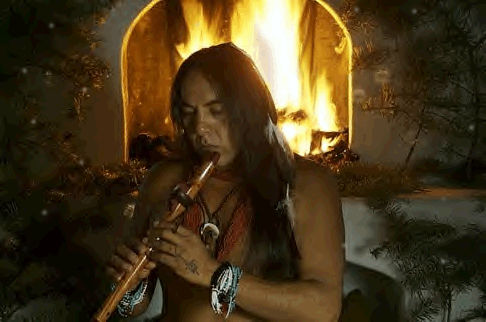
Robert Mirabal


It is rare for a musician to receive virtual artistic freedom from a major label, and equally rare for a culturally authentic act to achieve mainstream popularity, yet Robert Miraba manages to do both. Nicknamed Toop-yah-oh (Flute Song) in his Native American Tiwa language, Mirabal is a multitalented instrumentalist who plays percussion, keyboards, ocarina, didgeridoo, and even crafts his own flutes. A true renaissance man, Mirabal has also written poems, prose, and screenplays.


Born in the American Southwest in the late 1960s, Mirabal hails from the high northern desert of Taos, New Mexico, an ancient land that sits at the foot of the Sangre de Cristo Mountains. The land has been the tribal territory of Taos Pueblo Indians for more than 1,000 years, and it is still home to 2,000 people who live in harmony with ancestral traditions, governed by a tribal council.
Raised primarily by his mother and grandmother in a matriarchal community, Mirabal endured separation from both his father and from his brother, Patrick, for much of his childhood. During these years he lived closely with his grandparents and helped care for them in their later years. Although their small group was comprised largely of women, children, and the aged, the environment was a stable one.
Simple Beginnings, Broad Horizons:
Mirabal's early musical education was limited to middle school enrichment courses at the Pueblo Indian School. After trying the clarinet and saxophone, he took up piano and developed a marked interest in percussion as well, gradually adding new instruments to his repertoire.
At 18, using funds borrowed from his grandmother, he bought an Adam Trujillo flute at auction. In time, Mirabal's fascination with the flute became a serious artistic pursuit, and he crafted a double-chambered instrument of his own. During these earl y days he performed with the Taos Mountain Shadow Dancers from the Pueblo.
Mirabal was also inspired by popular mainstream musicians such as Bruce Springstein, John "Cougar" Mellencamp, and the Doors. A 1987 trip to Russia introduced him to the balalaika and gave him the opportunity to talk to other musicians. On his return to the United States he borrowed more funds and in 1988 recorded a self-produced album, Robert Mirabal. By the early 1990's he had produced three albums on cassette through his independent label, Yellow Aspen Cloud Productions, in Taos.
In 1990 Mirabal toured internationally with Japanese dancers Eiko and Koma, which gave him the opportunity to study the rigorous art of Taiko drumming during a visit to Japan. A dance suite, written by Mirabal on commission from Eiko and Koma, won a New York Dance and Performance Bessie Award in 1992.
Major Label Career:
After releasing his independently produced album Song Carrier in 1995 he signed a deal to record seven albums for Warner Western, a Native American label backed by Warner Bros. Records. By 1996 he had released three albums through Warner Western, selecting the 90-minute dance suite commissioned for the Eiko & Koma Troupe as his Warner debut. For this recording Mirabal headed eastward, to Echo Park Studio in Bloomington, Indiana. There, working with Mike Wanchic, Mirabal recorded the eight-track dance program and titled the album Land. The album Warrior Magician, released soon afterward, showcased Mirabal on flute and didgeridoo. He was by then well established on the New York club scene, where he maintained a band called the Kraze Kunoe Tribesmen, whose members hail from the West Indies, Britain, and Australia. In other collaborations, he worked with Bill Miller on Native Suite: Chants, Dances, and the Remembered Earth.
In 1997 Mirabal's career took a new turn, expanding into a style that was whimsically billed as "alter-Native" music. He began to experiment with new rhythms and styles, combining creative groupings of instruments and experimenting with hip-hop, techno, and other popular genres. He expanded his touring schedule and released "Mirabal" an album reflecting this new mood.
By 1999 Mirabal was a respected crossover artist. He accompanied John Tesh on the "One World Tour" and cohosted a Public Broadcasting System (PBS) the fund-raiser of the same name. Mirabal brought a new dimension to his
performances that year by recording several songs in his native Tiwa tongue. They were featured on a 13-track album called "Taos Tales," which, despite the songs' authentic language, was recorded in the rock tradition, a decided contrast to the ethereal tone of his earlier recordings. As the year wound to a close Mirabal completed a run on Broadway in Peter Buffet's "Spirit: A Journey in Dance, Drum, and Song" in December 1999 prior to embarking on an American tour with the production.
Multitalented Musician:
Mirabal, known for his musical diversity, does not hesitate to incorporate electric guitars and synthesizers into the rustic mix of native flutes and ocarina. He is equally comfortable on percussion and keyboards, and is recognized for his artful fusion of hip-hop, West Indian, and West African influences, which he blends with Japanese drums, Celtic rhythms, and traditional Native American harmonies. As he confided to interviewer Rita Rose of his eclectic style, "My music comes from an ancient place."
In 2001 Mirabal released "Music from a Painted Cave", a live concert recorded on December 16, 2000, at the Fox Theater in Mashantucket, Connecticut, before a crowd of 2,000. For this elaborate program Mirabal was joined by one of his bands, Rare Tribal Mob (an anagram of Robert Mirabal). Mob musicians vary, but the group regularly includes Heart bassist Mark Andes and his brother Matt Andes of Spirit, Mirabal's cousin, Reynaldo Lujan, contributes tribal rhythms and vocals; Michael Kott performs on cello; and Estaban (Steve) Castillo is lead guitarist. Also joining the group on Painted Cave were vocalist Star Nayea, Robin "Hood" Peffer on bass, and Mirabal's brother, Patrick, on vocals, flutes, and percussion. Drummer and percussionist Kenny Aronoff (John Mellencamp), is also heard on this album. Choreographed by Boye Ladd, a video version of Music from a Painted Cave aired as a concert special on PBS on March 8, 2001. Reviewing a live performance of this work, Daune Stinson in News from Indian Country said of the extravaganza, "It's just about the most beautiful piece of theatre, and ... splendor." Native American Times called this work, "An evolutionary vision of one man from birth's breath to the metamorphosis of time." The album peaked at number six on the Billboard charts.
In 2002 Mirabal appeared at the New Orleans Jazz & Heritage Festival's Celebration of Native American Art. In 2003 he released his a DVD-enhanced compact disc "Indians", that treats listeners to traditional spoken stories i n addition to songs and music.
His short story collection, Skeleton of a Bridge, was published by Blinking Yellow Books in 1995. His flutes have been displayed at the Smithsonian Institute in Washington, D.C., and his artwork was included in Native American Artist's of North America. Mirabal's writings were used by Robert Redford to compile the documentaries "Silent Witness and Sacred Sites"
Mirabal has received numerous grants and academic honors, among them a Meet the Composer Grant from the National Endowment for the Arts. In the fall of 1995 he served as artist in residence at the University of Nebraska-Lincoln and held similar posts at Dartmouth College and Cambridge. A respected composer, Mirabal's works have been performed at the John F. Kennedy Center for the Performing Arts and at the Brooklyn Academy of Music. On May 30, 2003, the Taos County Chamber of Commerce proclaimed Robert Mirabal Day in Taos.
Mirabal continues to live a traditional life at the bottom of the scared Sangre de Cristo Mountain range in Taos Pubelo, New Mexico. He maintains a shop on the Pueblo, is very active in his community, continues to perform and is very close to his three daughters. His PBS Special" "Music From A Painted Cave" is still considered a benchmark in Native American theatrical performance.
